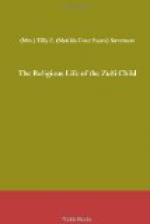1 North. 2 West. 3 South. 4 East. 5 Heavens. 6 Earth.]
They come after sundown to the village. The serpent, made of hide, is about twelve feet long and eighteen inches through the thickest part of the body. The abdomen is painted white, the back black, covered with white stars, which are represented by a kind of semicircle, an entirely conventional design. The neck rests through a finely decorated kind of altar carried by the two Soot-[=i]ke. The tail end of the fetich is held by the priest of the K[=o]-l[=o]-oo-w[)i]t-si, who constantly blows through a large shell, which he carries in the right hand, holding the serpent with the left. The K[=o]k-k[=o] pass through the town and visit each kiva; they put the head of the serpent through the hatchway, that those who are privileged to assemble in the kivas may see the fetich. The K[=o]-l[=o]-oo-w[)i]t-si is then taken to the Kiva of the Earth, H[=e]-tk[=a]-pa-que. The walls of this kiva are decorated with two K[=o]-l[=o]-oo-w[)i]t-si, which extend almost around the entire walls of the room, the heads nearly meeting at the north end of the room. The fetich is placed between the heads. The others of the K[=o]k-k[=o] repair to their respective kivas, the H[=e]-i-i-que or Kiva of the North, the Moo-h[=e]-i-que or Kiva of the West, the Choo-p[=a]-ae-que or Kiva of the South, the [=O]h-h[=e]-i-que or Kiva of the East, and the Oop-ts[=a]n-[=a]-[=a]-que or Kiva of the Heavens. From each of these kivas men and youths from the secret orders to which I have referred are assembled to receive the K[=o]k-k[=o]. When all the K[=o]k-k[=o] have gone to their kivas, the ten K[=o]-y[=e]-m[=e]-shi, who reach the village after the others, go to their house, which is not one of the sacred assembly houses, but chosen from among the S[=u]s-ki-i-que, or people of the Wolf gens.
The K[=o]k-k[=o] sing and dance in their own kivas, then change about, those of the North passing to the West and those of the West going to the South, and so on. This is continuous until the first white streak warns them that day is approaching. At this time the head of the K[=o]-l[=o]-oo-w[)i]t-si is put through the opening in the side wall of the kiva, when all who choose may look upon it. Behind this creature the old priest stands and blows through the body, making the same peculiar noise, representing the roaring of a sea monster, that he has kept up throughout the night. The image is only seen by the uncertain light of the faintest impression of day. P[=a]-oo-t[=i]-wa remains with the K[=o]-l[=o]-oo-w[)i]t-si in the Kiva of the Earth. At sunrise the Sae-lae-m[=o]-b[=i]-ya go to this kiva, each bearing the plume stick made on the sixth day and an ear of corn. The Sae-lae-m[=o]-b[=i]-ya of the North first advances to the priest of the K[=o]-l[=o]-oo-w[)i]t-si and, presenting him with the plumes and ear of yellow corn, prays that the K[=o]-l[=o]-oo-w[)i]t-si will




